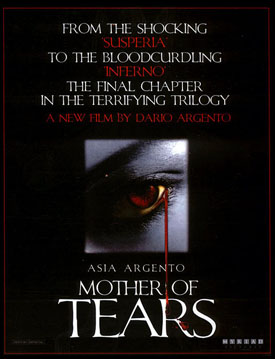
 You can’t go home again. I thought Dario Argento learned that in 1980 after making the laughably bad Inferno, ostensibly a sequel to his landmark Suspiria. But he’s back again with the third part in this so-called trilogy. Taken as a whole, the three films bear little relation to one another. Inferno and Mother of Tears at least make a reasonable pair, as they’re both terrible by any estimation.
You can’t go home again. I thought Dario Argento learned that in 1980 after making the laughably bad Inferno, ostensibly a sequel to his landmark Suspiria. But he’s back again with the third part in this so-called trilogy. Taken as a whole, the three films bear little relation to one another. Inferno and Mother of Tears at least make a reasonable pair, as they’re both terrible by any estimation.
A casket is unearthed with a heavily marked box chained to it. The box is sent to Michael Pierce, an authority on the symbols decorating the box. His student and lover Sarah (Asia Argento) and one of Pierce’s colleagues open the box without him, unleashing hell upon Rome. People go wild in the streets, monkeys sniff out human prey for demons and the Third Mother, the most powerful witch of all, is reborn. Mater Lachrymarum, the Mother of Tears.
I’m not concerned with the ever-thin thread of narrative that guides this movie. Characters are introduced and dispatched with an equal lack of gravity? Sure. The dementia gripping the streets of Rome seems to do so as budget dictates? No problem. Udo Kier makes Malcom McDowell’s Halloween performance look like Laurence Olivier? Okey-doke; even making him look like Mary-Kate Olsen would be an improvement.
When he’s really cooking, Argento doesn’t need story or even character. Suspiria was wildly successful with only the most vague dream logic. Even his more traditional thriller films (Bird With The Crystal Plumage, Cat O’ Nine Tails) were wholly subjective and willing to embrace mighty gaps of narrative. No, his best work has long been about atmosphere and the oppressive use of light and sound.
Mother of Tears has a great void where those qualities should be. Whenever it tries to create atmosphere, this movie is an abject failure. It’s flat and cheaply lit, with an obvious use of colored light and a lack of shadow fit for 1980’s television. There’s not one moment of visual tension, and watching my dog try to find a new place in the back yard to shit provides a more unpredictable viewing experience.
The soundtrack is just as bad, blaring and stupid instead of loud and intimidating. That Claudio Simonetti is responsible makes me cry. Thanks to him, I’m the Father of Tears. He hired Danni Filth to sing the exit song…and my keyboard is wet with salty eye excretion even now.
Don’t think I didn’t notice the one time a theme reminiscent of Goblin’s great ’70s soundtracks came into play — during a seemingly endless cab ride, no less — and how the film actually perked up for a moment at the relentless drums and rasping voices.
You might hear from a distracted few that gore makes this movie worthwhile. There’s a lot of it, true, and it’s mostly well-crafted. (Given the film’s budget.) Frequently, it’s unleashed against faces. Argento has always shared Fulci’s weakness for eyes, and quite a few are gouged. But unlike Suspiria, which built up to gore with impressive set pieces, here the red stuff is typically just dumped out. It’s the old criticism come to life: Argento realizes he’s got nothing in the tank, so he smashes another face.
Then there’s the group of witches that menaces Rome and then congregates under and old house with the Mother of Tears. The snarling, snapping trollops act like they’re on a fashion runway, not a path of destruction. They look ready to recreate the amazing cover to Ratt’s seminal record ‘Out of the Cellar’. Ooooh, threatening! And the Mother of Tears is just another hot, pneumatically enhanced babe with her tits out. Not much competition for the wheezing old bird in Suspiria. And the source of her power? A smock! Spoiler!
I’ll grant the movie a few good moments. Monkeys acting as bloodhounds for a couple of demons is a cool idea, and there’s one bit where a bald assassin opens his mouth incredibly wide to menace Asia Argento through a phone. Trust me, it works. And miserable as he was, I got a good laugh out of Udo Kier. In fact, I got a lot of good laughs out of the entire film. If only I wasn’t so aware that Argento had a very different response in mind.